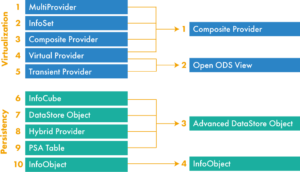4 Ways SAP’s “Run Simple” Affects Your EDW Landscape
Recently, SAP® has been vocal about promoting simplification as a business driver for software enhancements. From a marketing campaign utilizing “Run Simple,” to the engineering focus on the “Simplification List for S/4HANA,” the SAP software has been emphasizing optimized code, table structures, and object types in S/4HANA and BW/4HANA. In this blog, we’ll analyze how this buzzword “Simple” affects your BW landscape, your modeling best practices, and to a certain extent, your capability to deliver on complex business needs.
With the impact of IoT and digital disruption being felt by most industries, there is a lot of focus and progress around simplifying the business. A simplified business supported by a Simple S/4, or BW/4, or BW on HANA empowers business functions with real-time actionable insights, which allows your user community to focus on innovation and agility. This simplification fever is infecting the SAP portfolio, and we’re excited about the impact it’s having on our clients.
1. SAP S/4HANA
One of the key enablers for S/4 HANA is the simplification of applications and the underlying data model by reducing a number of index tables and aggregate tables, thus reducing the overall in-memory footprint. The inclusion of some of the business functions into the S/4HANA 1610 Core is also a key step aimed towards simplification. By incorporating Product Planning as part of Logistics, for example, SAP has enabled simplification. Overall, it provides a simpler transactional system with better real-time analytical insights.
For a small to a mid-size client, this allows the possibility of using S/4HANA along with Embedded Analytics or an Embedded BW within S/4, for complex real-time reporting capabilities instead of a separate EDW which in turn becomes a simplified landscape.
2. EDW using BW on HANA, BW/4HANA or SQL-based
SAP recently confirmed its data warehousing strategy, focusing on a SAP BW approach, a SQL approach (Native HANA) and a mixed mode approach. For most of us in the BI/Analytics space, it is not a surprise that SAP will focus on both BW & Native HANA approaches; however, we continue to see more synergies, in terms of modeling options and tools, multitier data management, and data integration across these two approaches.
3. HANA Modeling
As HANA Studio evolves with different perspectives for ABAP developers, BW developers, and Native HANA developers, it gives a unified development tool and more capabilities to build and re-use HANA optimized objects in S/4 and EDW. For example, in our recent Suite on HANA implementation for one of our clients, we were able to standardize and leverage re-usable CDS views across BW & Suite on HANA enhancements.
4. Virtual is the future
As we explore and exploit the capability of HANA in BW 7.4 or 7.5 on HANA or BW/4, the number of building blocks for BW modeling has been significantly simplified and clearly, the future is going to be on the Virtual layer.

Combining the Virtual layer with the CDS view that you could build in Suite on HANA (SoH) or S/4HANA or BW on HANA or BW/4 gives you much more virtualization capability, starting from your transactional system, through EDW and to your reporting solution. To add on to this, including the possibility of Open ODS on Direct access data source enables real-time access in BW or BW/4. These virtual data models open new, challenging, and disruptive possibilities in data modeling, giving us opportunities to remodel, optimize our physical data models with more virtual models, and ever-reduce our in-memory footprint and total cost of ownership
As an architect building an SAP HANA solution, the design possibilities are quite different and much more open compared to the traditional BW data modeling. It is an interesting and exciting journey as we continue to learn and leverage the HANA capabilities
Sivakumar KA, a SAP HANA program manager for Clarkston Consulting, was a key contributor to this research.
Join us at the SAPPHIRE NOW + ASUG Annual Conference 2017, Wednesday, May 17th at 12:30pm at S310C (South Concourse Level 3) as Clarkston Consulting’s Nathan Keliher and Rajkumar Maheshwari, DW Manager from Benjamin Moore, walk you through a compelling example of how we have built a flexible and future-proof EDW for Benjamin Moore using HANA. The presentation will focus on the architecture, scenarios, and how we challenged ourselves for the most optimal design for flexibility, growth, in-memory footprint, and user experience.



